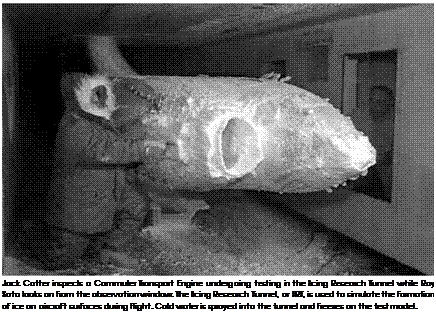Education and Training
To support NASA’s ongoing goal of improving aviation safety, the Education and Training Element of the Aircraft Icing Project continues to develop education and training aids for pilots and operators on the hazards of atmospheric icing. A complete list of current training aids is maintained on the GRC Web site. Education materials are tailored to several specific audiences, including pilots, operators, and engineers. Due to the popularity of the education products, NASA can no longer afford to print copies and send them out. Instead, interested parties can download material from the Web site[1269] or check out the latest catalog from Sporty’s Pilot Shop, an internationally known source of professional materials and equipment for aviators.[1270]
Icing Branch Facilities
NASA’s groundbreaking work to understand the aircraft icing phenomenon would have been impossible if not for a pair of assets available at GRC. The more historic of the two is the Icing Research Tunnel (IRT),
 |
|
which began service in 1944 and, despite the availability of other wind tunnels with similar capabilities, remains one of a kind. The other asset is the DHC-6 Twin Otter aircraft, which calls the main hangar at GRC its home.
For ground-based research it’s the IRT, the world’s largest refrigerated wind tunnel. It has been used to contribute to flight safety under icing conditions since 1944. The IRT has played a substantial role in developing, testing, and certifying methods to prevent ice buildup on gas-turbine-powered aircraft. Work continues today in the investigation of low-power electromechanical deicing and anti-icing fluids for use on the ground, deicing and anti-icing research on Short Take Off and Vertical Landing (STOVL) rotor systems and certification of ice protection systems for military and commercial aircraft. The IRT is a closed – loop, refrigerated wind tunnel with a 6- by 9-foot test section. It can generate airspeeds from 25 to more than 400 miles per hour. Models placed in the tunnel can be subjected to droplet sprays of varying sizes to produce the natural icing conditions.[1271]
For its aerial research, the Icing Branch utilizes the capabilities of NASA 607, a DHC-6 Twin Otter aircraft. The aircraft has undergone many modifications to provide both the branch and NASA a "flying laboratory” for issues relating to the study of aircraft icing. Some of the capabilities of this research aircraft have led to development of icing protection systems, full-scale iced aircraft aerodynamic studies, software code validation for ground-based research, development of remote weather sensing technologies, natural icing physics studies, and more.[1272]










